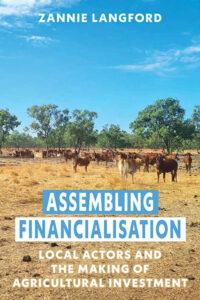Dr Zannie Langford of the Griffith Agribusiness team explores the complexities of negotiating agricultural investment in Northern Australia in her new book, Assembling Financialisation: Local Actors and the Making of Agricultural Investment.
Dr Langford uses the concept of financialisation to explore the drivers and effects of agrifood restructuring in Northern Australia, while assemblage theory is applied to position local people as key actors in negotiating connections between local spaces and global finance.
She examines the work the people negotiating financial investments do, the tools they use, and the spaces they work across to better understand how agricultural investments come to be structured as they are, and the outcomes they produce.

“In 2015, the White Paper on ‘Developing Northern Australia’ outlined plans for the development of the region, part of which was a focus on attracting private finance for development,” Dr Langford said.
“This book explores the ways that local people engage with investors to negotiate the structure of agricultural development projects.
“Through in-depth research with farmers, land valuation professionals, rural lenders, Indigenous organisations, and government officials, this book reveals that northern Australian professionals play a key role in negotiating investments and contributes to understandings of financialisaton as an assemblage by showing how financial investments play out differently in different contexts.”
Dr Langford demonstrates that while financialisation is a useful signifier of patterns of global change, it is assembled by a diverse range of often contradictory work, suggesting the need for more grounded policy on northern Australian agricultural development, sensitive to the range of ways that finance-led agrifood transformations occur at the local level.
Assembling Financialisation has been highly reviewed by leading agrifood research scholars.
André Magnan describes it as ‘A theoretically sophisticated and nuanced account of how local actors respond to and mediate both the discursive and material dimensions of financialisation’, while Michael Carolan notes that it ‘Fills a gap in the literature by foregrounding the processes that underpin agrifood financialisation trends, framing them as negotiated phenomena that are made and remade at the level of everyday life.’
Assembling Financialisation: Local Actors and the Making of Agricultural Investment was published by Berghahn Books and is available for purchase on its website.
